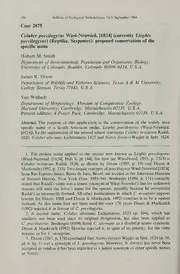
Case 2875. Coluber Poecilogyrus Wied neuwied, (1824) (Currently Liophis Poecilogyrus) (Reptilia, Serpentes): Proposed Conservation Of The Specific Name PDF
Preview Case 2875. Coluber Poecilogyrus Wied neuwied, (1824) (Currently Liophis Poecilogyrus) (Reptilia, Serpentes): Proposed Conservation Of The Specific Name
. 250 Bulletin ofZoological Nomenclature 51(3)September 1994 Case 2875 Coluberpoecilogyrus Wied-Neuwied, |1824] (currently Liophis poecilogyrus) (Reptilia, Serpentes): proposed conservation of the specific name Hobart M. Smith Department ofEnvironmental, Population and Organismic Biology. University ofColorado. Boulder. Colorado 80309-4)334. U.S.A. James R. Dixon M Department of Wildlife and Fisheries Sciences, Texas A & University, College Station, Texas 77843, U.S.A. Van Wallach Department ofHerpetology. Museum ofComparative Zoology, Harvard University. Cambridge. Massachusetts 02138, U.S.A. Present address: 4 Potter Park, Cambridge. Massachusetts 02138. U.S.A. Abstract.The purpose of this appUcation is the conservation of the widely used specific name of a South American snake, Liophis poecilogyrus (Wied-Neuwied, [1824]), by the suppression ofthe unused senior synonyms Coluberm-nigrum Raddi, 1820, ColuberaUernans Lichtenstein, 1823 and NatrixforsteriWagler in Spix, 1824. 1 The earliest name applied to the species now known as Liophis poecilogyrus (Wied-Neuwied. [1824], Heft 8, pi. [44]; for date see Woodward, 1915, p. 2315) is Coluber m-nigrum Raddi, 1820, as shown by Dixon (1989, p. 19) and Dixon & Markezich(1992,p. 133).TwofemalesyntypesofpoecilogyrusWied-Neuwied[1824], from Rio Espirito Santo, BarradeJuca, Brazil, arelocated at theAmerican Museum of Natural History, New York (Nos. 3593-94). Boulenger (1894, p. 131) correctly stated that Raddi'snamewasaseniorsynonymofWied-Neuwied'sbut forunknown reasons still used the latter's name for the species, possibly because he interpreted Raddi's as incorrectly formed. All other publications in which C m-nigrum appears (except for Dixon, 1989 and Dixon & Markezich, 1992) consider it to be a nomen dubium. As this name had not been used for over 170 years Dixon & Markezich (1992) rejected it in favour of C. poecilogyrus. 2. A second name. Coluber alternans Lichtenstein, 1823 (p. 104), which has similarly not been used since its original designation, has also been applied to C. poecilogyrus. Boulenger (1894) listed C. altermms as a doubtful senior synonym. Dixon & Markezich (1992) likewise rejected it, in spite ofits priority, for the same reasons as for C. m-nigrum. 3. Dixon(1987,p. 174)concluded that NatrixforsteriWsLglerin Spix, 1824(p. 16, pi. 4. fig. I) was a synonym ofL. poecilogyrus. However, A', forsteri has never been accepted asvalidasit has been regarded asajuniorsynonym ofotherspecific names in Natrix. Bulletin ofZoological Nomenclature 51(3) September 1994 251 4. Afurthersynonym. ColuberdoliatusWied-Neuwied, 1825appearedinthesame work as C. poecilogyrus but as a junior primary homonym of Coluber doliatus Linnaeus, 1766 it is invahd. 5. The name Liophis poecilogyrus was accepted by Dixon & Markezich (1992) "because of its usage in 52 primary articles as the vahd name for the taxon". This usage began as early as Wagler (1830, p. 188), who was also the first to use the now accepted combination Liophispoecilogyrus. 6. Weconsiderthatitisimperativein theinterest ofstabilitythatthespecificname poecilogyrus Wied-Neuwied. [1824] be maintained for the species to which it now applies. We have given the Commission Secretariat a list often works ofthe last 50 years which have used the binomen L. poecilogyrus; as examples we cite Parker (1931), Michaud & Dixon (1989), Perez-Santos& Moreno (1991). Hofstadler(1992). 7. The International Commission on Zoological Nomenclature is accordingly asked: (1) to use its plenary powers to suppress the following specific names for the purposes of the Principle of Priority but not for those of the Principle of Homonymy: (a) m-nigruni Raddi, 1820, as published in the binomen Coluber m-nigruin; (h)alternans Lichtenstein, 1823, as published in the binomen Coluber alternans; (c) forsteriWagler in Spix, 1824, as published in the binomen Matrixforsteri; (2) to place on the Official List of Specific Names in Zoology the name poecilogyrus Wied-Neuwied, [1824], as published in the binomen Coluber poecilogyrus; (3) to place on the Official Index of Rejected and Invalid Specific Names in Zoology the following names: (a) m-nigrum Raddi. 1820. as published in the binomen Coluberm-ttigrum and as suppressed in (l)(a) above; (b) alternansLichtenstein, 1823, aspublished inthebinomen Coluberalternans and as suppressed in (l)(b) above; (c)forsteri Wagler in Spix, 1824 as published in the binomen Matrixforsteri and as suppressed in (l)(c) above. References Boulenger,G.A. 1894. CatalogueoflliesnakesintheBritish Museum (NaturalHistory),vol. 2. 382 pp. Taylor& Francis, London. Dixon, J.R. 1987. Taxonomy and geographic variation o(Liophis lyphtus and related 'green' species ofSouth America (Serpentes: Colubndae). Annals ofthe Carnegie Museum, 56: 173-191. Dixon,J.R. 1989.AkeyandchecklisttotheNeotropicalsnakegenusLiophiswithcountrylists and maps. Smithsonian HerpetologicalInformation Service, 79: 1^0. Dixon, J.R. & Markezich, A.L. 1992. Taxonomy and geographic variation of Liophis poecilogyrus (Wied) from South America (Serpentes: Colubridae). Texas Journal of Science, 44: 131-166. Hofstadler, D.C. 1992. Nota sobre registro de copula heterloga em Liophis Wagler, 1830 (Serpentes). Acta Biologica Leopold. 14(1): 83-86. Lichtenstein, H. 1823. Verzeichniss der Douhletten des zoologischen Museums der Konigl. UniversildtzuBerlinnebstBeschreibung vielerbisherunhekanntenArten von Saugethieren, Vogeln, Amphibien undFisclien. 118 pp. Trautwein, Berlin. 252 Bulletin ofZoological Nomenclature 51(3)September 1994 Linnaeus,C. 1766. Syslemanalurae..., Ed. 12, vol. 1, part 1. Pp. 1-532. Salvii, Stockholmiae. Michaud, E.J. & Dixon,J.R. 1989. Prey itemsof20species oftheneotropicalcolubridsnake genus Liophis. Herpetological Review, 20(2): 39-41. Parker, H.M. 1931. Reports on an expedition to Brazil and Paraguay in 1926-7. Araphibia- Reptilia. Journalofthe Linnean Society ofLoiuhn. Zoology. 37: 285-289. Perez-Santos, C. & Moreno, A.G. 1991. Serpientes de Ecuador. Museo Regionale di Scienze Nalurali. lonno, 11: 1-538. Raddi,G. 1820. Diealcunespeciesnuovedi rettilieplanteBrasilien. AttidellaSoeietaItaliana di Scienze Naturalidi Modena, 18: 1-39. Spix,J.B.von. 1824.SerpenlumBrasiliensiumspeciesnovae... 75pp. Hiibschmanni, Monachii. Wagler, J.G. 1830. Natiirliches System der Amphihien. mit vorangehender Classification der Sdugethiereund Vogel. 354 pp. 9 pis. Miinchen. Stuttgart & Tubingen. Wied-Neuwied,M.A.P.von.[1824]. AhbildungenzurNaturgeschichteBrasiliens, Hefts5-8,pis. 25^8. Landes-Industrie-Comptoirs, Weimar. Wied-Neuwied, M.A.P. von. 1825. Beitrdge zur Naturgeschichte von Brasilien, vol. 1. 614 pp. Landes-Industrie-Comptoirs, Weimar. Woodward, B.B. 1915. Catalogue ofthe books, manuscripts, maps anddrawings in the British Museum (NaturalHistory), vol. 5. Pp. 1957-2403. British Museum, London.
